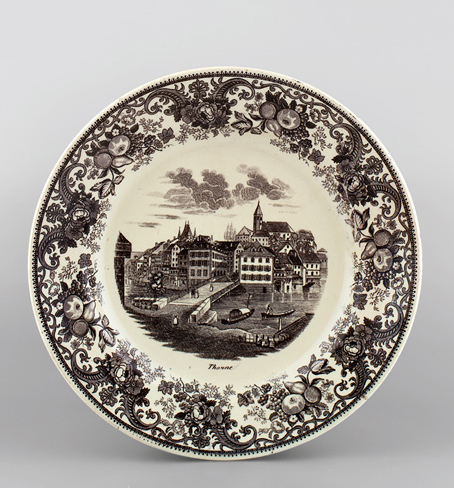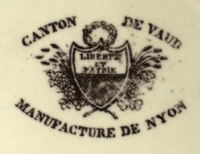

See also Nyon, Canton of Vaud, the refined white earthenware manufactories (2)
In the archives of the Historical and Porcelain Museum in Nyon (Musée historique et des porcelains de Nyon MHPN), while leafing through the workshop journal of Lausanne engineer Frédéric Gonin, who would later take over the running of the Nyon Manufactory, we found a description of a firing test on yellow cookware which contained the following, rather enigmatic, note: “In Casamène we were firing…”. It seems to suggest that Gonin worked in a manufactory known to have been located in the industrial district of Casamène, a suburb of Besançon (Doubs, France), which produced amongst other wares refined white earthenware. A short chapter about the factory in a book about the refined white earthenware factories and their products in the Franche-Comté region by Louis and Suzanne de Buyer (De Buyer and de Buyer 1983) not only confirms the assumption, it even speaks about a fairly important connection between the Nyon entrepreneurs and the refined white earthenware factory at Besançon, which has up to now has never been mentioned in Swiss sources. According to the book, the Casamène Manufactory (the first of its kind in this location) was founded by two entrepreneurs from Nyon in 1841: “Mr de Bons, a former governor of the Canton of Vaud, and Mr de Flachère [sic]” (de Buyer and de Buyer 1983, 103 – the authors also refer to an official act initialled on 2nd July 1841 in Besançon).
While de Bons was perhaps involved in setting up the project, he was no longer part of its implementation: he died on 11th November 1840. A few years after taking over the running of the company in Nyon, some of the leading figures involved in the factory in Vaud seem to have opened a second manufactory on French soil (for examples of the wares produced in Besançon see MHPN MH-FA-3876-1; MHPN MH-FA-3876-2; MHPN MH-FA-3876-3; MHL AA.MI.991, MPE No. 22). Frédéric Gonin himself is mentioned as the “technical advisor” (de Buyer and de Buyer 1983, 104). The enterprise appears to have been very successful: according to de Buyer, it employed 120 workers in 1844. The refined white earthenware products from Casamène have black-brown and sometimes even two-tone printed decorations. The latter are plates with black-brown motifs on the well and blue or red ones on the lip.


One of the examples reproduced by the de Buyers is a plate with a view of Thun on its well. It is identical to one that appeared more or less at the same time on products from Nyon (MHPN MH-FA-535; MHPN MH-FA-10023B).
While the decorations on the lips are different, the motif in the centre appears to have come from the same engraving. A series of motifs seem to have circulated between Nyon and Casamène. This also explains the presence in Nyon of rather exotic illustrations that refer to the lives of French soldiers, for example the cross of the Legion of Honour (La Croix d’honneur; MHPN MH-2003-127; MHPN MH-FA-10022; MHPN MH-FA-1827) or a humorous depiction of everyday life in Napoleon’s army, a motif that was widely used to adorn French wares (MHPN MH-2003-126).
A paragraph entitled “Casamène” in the catalogue of the Museum in Sèvres by Alexandre Brongniart and Denis-Désiré Riocreux reads: “Three examples of perfect refined white earthenware with a hard glaze based on boron compounds, produced under the direction of H. Gonin, civil engineer, 1844”. A plate with “arabesque friezes and a view of Zurich” and two “English cups decorated with flowers and landscapes” can be added to this little group of objects. All decorative motifs were printed in blue and black (Brongniart and Riocreux 1845, cat. no. 21). The reference to people from Nyon being involved in creating this manufactory and the ties between the two places of manufacture are clearly deserving of more in-depth research, but this would go beyond the remit of our work.
The venture of the Nyon entrepreneurs in the Franche-Comté region came to an abrupt end when the Delafléchère family in Nyon went bankrupt. In 1845, the Casamène Manufactory changed hands and also direction in terms of its products (de Buyer and de Buyer 1983, 105).
Translation Sandy Haemmerle
References:
Brongniart et Riocreux 1845
Alexandre Brongniart et Denis-Désiré Riocreux, Description méthodique du Musée céramique de la Manufacture royale de porcelaine de Sèvres. Paris 1845.
De Buyer et de Buyer 1983
Louis de Buyer et Suzanne de Buyer, Faïences et faïenceries de Franche-Comté. Besançon 1983.

